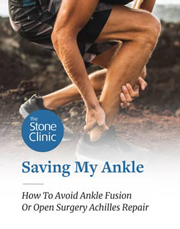Ankle Pain: Why it Hurts and When to Worry
Hear From Our Patients
Patient Avoids Ankle Fusion with BioAnkle Cartilage Repair SurgeryThough the ankle is a relatively small joint, at the bottom of your entire body, it takes the full weight of walking and running, one side at a time. Despite multiple ankle sprains and high jumps throughout life, something unique about the cartilage of the joint protects it. Remarkably, the ankle rarely develops arthritis—unless it has had a fracture. If your ankle is indeed injured, here is when (and how much) to worry.

No Worries: Ligament micro-tears with mild pain & no swelling
Slight pain—most commonly over the anterior lateral side of the ankle, after mild twists—is the most common complaint. The anterior talofibular ligament holds the small bone of the fibular to the primary bone of the ankle (the talus). The anterior talofibular is the most commonly injured ligament and, if torn, can lead to ankle instability. However, mild aches after small, unplanned twists are likely caused by micro-tears in the stabilizing collagen fibers of the ligament—small injuries that bring in inflammatory and repair cells. The tiny amount of increased blood flow leads to a trace or unnoticeable amount of swelling, and mild pain. These injuries heal on their own without treatment, though ice and massage make the ankle area feel better. Using more supportive running shoes, or arch supports, can help prevent some of these injuries.
More Worry: Ligament tears with intermittent pain & instability
Tears of the ligaments on either side of the ankle, if not healed fully, lead to instability. Fortunately, the ankle ligaments are bathed in a robust blood supply, giving them great natural healing ability. They heal best when they are protected with a brace, which permits the new collagen fibers to knit the ligament back together. If unprotected, the constant abnormal motion of an unstable ankle leads to continued stretching of the fibers, with intermittent pain. Chronic pain at the ligaments often indicates that natural healing did not occur, in which case the ligaments may need to be repaired.
Other injuries within the ankle joint also can produce worrisome pain. These are most commonly due to disruptions of the cartilage surface of the talus, or stress fractures in the bones of the ankle joint. In this case, the ankle is stable but hurts with exercise or impact. If ignored, these injuries can worsen dramatically. An MRI is the only definitive way to make these diagnoses.
Real Worry: Swelling, chronic pain, & instability
Pain accompanied by swelling, whether acute or chronic, indicates a significant injury to the ankle tissues or bones. The swelling is initially caused by blood rushing to the site of injury to effect a repair. Continued swelling is usually due to excess joint fluid from chronic inflammation. In either case, repair is usually better than just living with it—since even the hardy ankle can develop disabling arthritis if left untreated.
Gross instability, caused by untreated stretched or torn ankle ligaments, is the most common affliction leading to pain with swelling. The ankle gives way when landing from a jump, and cannot be trusted on uneven walking surfaces. The “shucking” of the talus on the tibia, when the physician examines the ankle, is typical of this lack of stability. Like a car tire out of alignment, the ankle’s articular cartilage surfaces will wear out over time unless the stability of the ligament is restored.
Pain from impact without instability may be due to the articular cartilage or bearing surface of the joint being damaged. This can be caused by trauma, or by a disease called osteochondritis dissecans in which the bone and cartilage have an abnormal blood supply. In this case, an X-ray and MRI are often combined to make a definitive diagnosis. Fortunately, cartilage repair techniques (such as articular cartilage paste grafting) have successfully restored these surfaces in athletes of all ages. Even moderate or severe ankle arthritis lends itself to today’s novel biologic treatments. These treatments are most successful when employed early, and can reverse the disability of ankle arthritis.
Since we have all experienced many ankle injuries that have resolved themselves over time, we often ignore our own symptoms far longer than we should. For the ankle, “don’t worry, be happy” occurs only with early treatment.


